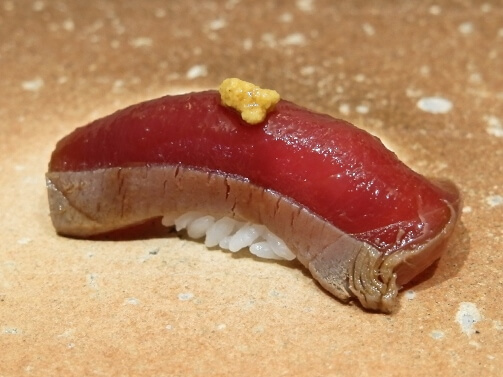
We hope this information will be helpful.
Revision date: September 16, 2019
Examples include red meat fish, white meat fish, silver-skinned fish, and fish roe etc. Depending on the sushi ingredients (sushi toppings), condiments such as soy sauce, salt, and Nikiri soy sauce are used differently. Outside of Japan, the sushi toppings such as avocado and cream cheese are preferred in place of raw seafood, something that is unthinkable of with traditional Japanese sushi.

We hope this information will be helpful.
Revision date: September 16, 2019

We hope this information will be helpful.
Revision date: September 4, 2019
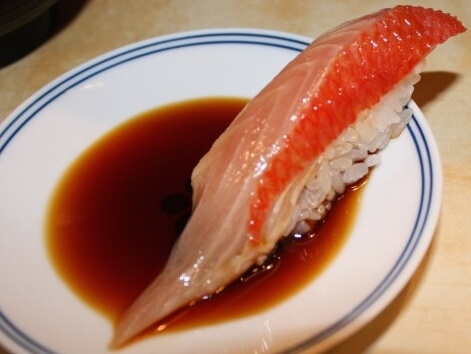
We hope this information will be helpful.
Revision date: June 11, 2019
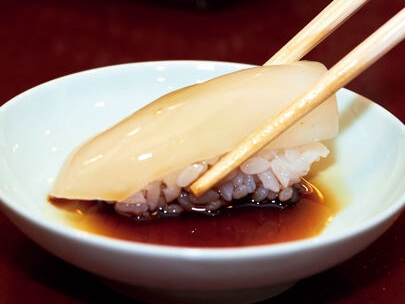
We hope this information will be helpful.
Revision date: June 4, 2019
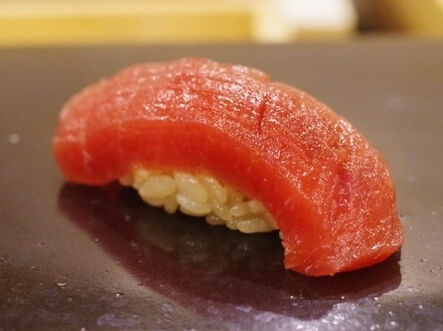
We hope this information will be helpful.
Revision date: April 22, 2019
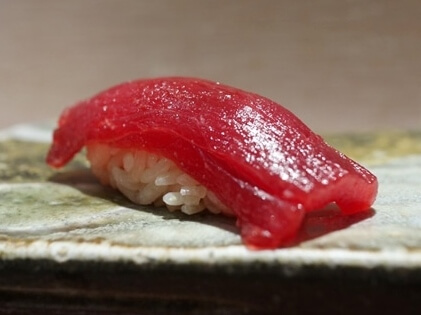
We hope this information will be helpful.
Revision date: April 16, 2019

Chilean fish farmers are using large quantities of antibiotics to control fish diseases. They use 500-700 times more antibiotics than Norway does. 80% of antibiotics imported into Chile are intended for the fish farming industry. Faced with the risk of bacteria resistant to antibiotics emerging, as highlighted by the World Health Organization (WHO), the Chilean National Fish Service is calling for a reduction in the use of antibiotics. (Extract from Le Monde diplomatique Japanese edition)
The bright color of salmon is something that you would never see a long time ago, but is now commonplace. It is likely due to the Canthaxanthin pigment mixed into their feed. Salmon is in fact a white fish. The salmon that is caught in Japan is called “Shirozake” or white salmon and its flesh is not a pink before it goes out to sea. Once it is out at sea, it swims around consuming small plankton and crustaceans such as shrimp and krill. Its body then takes on a pink color due to the intake of natural coloring of Astaxanthin. This Astaxanthin has antioxidant effects and it is noted for playing a part in relieving fatigue and preventing aging. However, the synthetic pigmentation that creates the salmon pink does not provide the same health benefits.
The US Food and Drug Administration (FDA) gave approval for genetically modified salmon on November 19th, 2015. This genetically modified salmon is called “AquAdvantage salmon.” It grows faster than regular salmon and its body length is almost double. There are groups opposing the sale of this salmon, including US citizen group Center for Food Safety, the Japanese Seikatsu Club, and the European parliament. There are still many unknowns regarding the safety of this type of fish for human consumption, and a number of issues are still being debated. The discussion has been featured in “Nature” magazine.
Endosulfan is a type of organochlorine compound, like Dichloro Diphenyl Trichloroethane, Dicofol, Heptachlor, Chlordane, Mirex, Pentachlorophenol, and is known to be extremely toxic, but the EU approved Endosulfan for use as feed in Norway’s salmon farming industry in 2013.
Researchers analyzed the risk-benefit ratio based on levels of contaminants like dioxins, PCBs and chlorinated pesticides versus omega-3 fatty acid levels. While farmed salmon is higher in omega-3s, it is also significantly higher in these toxins (about 10 times) which can produce birth defects, lower IQ, and cause cancer. They determined the following based on origin of the salmon: “consumers should not eat farmed fish from Scotland, Norway and eastern Canada more than three times a year; farmed fish from Maine, western Canada and Washington state no more than three to six times a year; and farmed fish from Chile no more than about six times a year. Wild chum salmon can be consumed safely as often as once a week, pink salmon, Sockeye and Coho about twice a month and Chinook just under once a month.” (Extract from The Journal of Nutrition)
On the other side of the debate, there are articles such as the following. Norway’s NIFES (National Institute of Nutrition and Seafood Research) sampled 13,180 farmed fish (of which 90% were salmon) and monitored them for medicines, substances that are prohibited by law, and other pollutants, publishing their report on August 17th 2015. In their latest report, it concluded that Norwegian farmed fish were safe and that illegal and undesirable substances were not observed to exceed standards. Further, it seems that they have confirmed decrease in most of the pollutants analyzed in the investigation.
But the fact is that, according to these articles, while the chemicals did not exceed standard values, they were certainly found to be present in farmed salmon. The other extreme would be to say that eating natural un-farmed salmon will not expose you to the potential risks from these types of chemicals.
However, that’s not really practical. The global production of farmed salmon is 2.5 million tons a year, approximately three times the 800,000 tons of naturally fished salmon. No matter what way you slice it, the option of farmed salmon isn’t going away anytime soon.
The Right Kind of Fishy: Can I Eat Raw Salmon?
We hope this information will be helpful.
Revision date: October 22, 2021
In the United States, Sea Bream is often called a Red Snapper. However, strictly speaking, this is not correct.
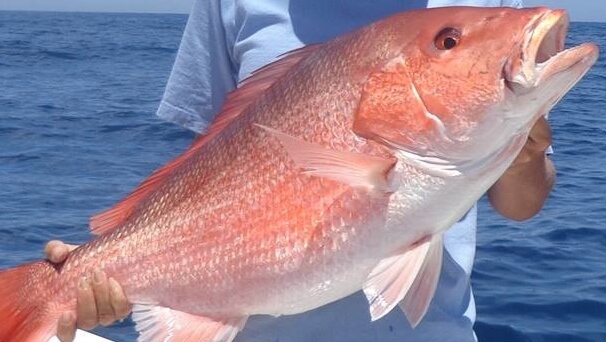
So, what is the fish that Japanese sushi restaurants call “tai”?
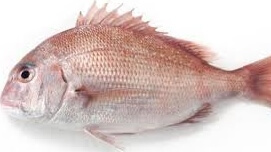
Incidentally, relatives of the sea bream often served at sushi restaurants include red sea bream (madai), crimson sea bream (chidai) and yellowback sea bream (kidai). While “kinmedai” (Splendid alfonsino) and “amadai” (horsehead tilefish) have the name “tai/dai” in them, they are not part of the same family as “tai”. Splendid alfonsino is a type of deep-sea fish.
Red sea bream and red snapper look similar, but when served as sushi, their texture and flavors are entirely different. So if you come to Japan, please try and eat natural madai. There is no “zatsumi” (overpowering bitterness) and it has a slight sweetness to it. This is the taste of tai, known as the king of the white fish. Just for your own reference.
Related Contents
https://sushiuniversity.jp/visual-dictionary/?Name=Red-seabream-(Tai)
We hope this information will be helpful.
Revision date: April 28, 2020

*It is said that nigiri-sushi in the Edo period was bigger than it is today, and too big to eat in one bite. In the Meiji period, the custom emerged of splitting this one big portion into two to make more easily consumed portions, and this is why it is common to get sushi in sets of two. However, nowadays making one piece of nigiri-sushi at a time is not very efficient. We think it’s actually easier for the sushi restaurant to make them in sets of two. Of course, you can order them one by one.
But the sushi restaurant won’t count them like that. Formally, sushi is counted in this way: Ikkan (one), Nikan (two).
We have absolutely no idea where the custom of using the “kan” counter came from. It’s also not clear when use of that counter for sushi started.
Of course, there are theories. For example, there is a theory that back at a time when a single unit of money was called “kan.” The price for one piece of sushi was around 1 ‘kan’, and the counting method gained popularity. There is another theory that one sushi roll was counted with the counter for roll “巻” (also pronounced “kan”), then a different kanji was used for it later. However, these are just theories that were created after the fact and the mystery remains unsolved.
Even if you ask the owner of a sushi restaurant, they’ll probably cock their head to one side, think for a moment, and tell you that the “kan” mystery may never be solved.
Sushi rolls wrapped in seaweed rolls are counted in units of 本 (hon/bon/pon) in the wrapped state, and when cut with a knife, the units change to 切れ (kire). While these units are fairly straight-forward for Japanese language speakers and easy to understand, only the enigmatic 貫 (kan) remains a mystery.
We hope this information will be helpful.
Revision date: April 29, 2020
The original negitoro is made from medium fatty tuna or nakaochi* chopped up finely with a knife and then mixed with chopped green onions on top. But the tuna may be switched out with filler, leading to a variety in quality of the negitoro available.
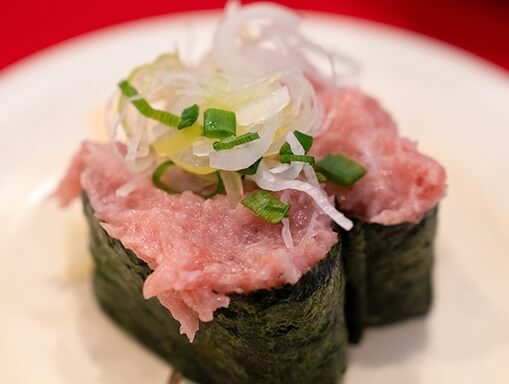
The medium quality uses the nakaochi of cheap Albacore tuna or Swordfish.
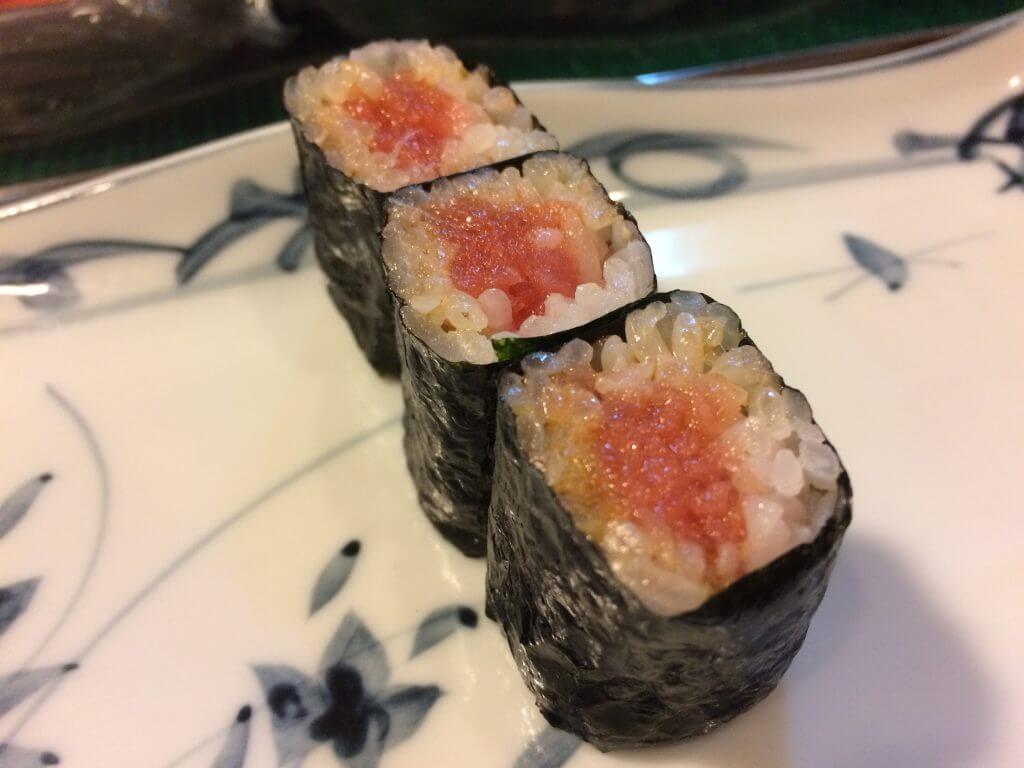
Finally, let me introduce some negitoro trivia. There is a lot of flesh on the middle bone (spine) and the surrounding area for tuna and the like. This is called “nakaochi*”. Scraping the meat from this area surrounding the spine is known as “negitoru”, which is where the word “negitoro” comes from. In other words, the name “negitoro” is not actually from the words onion (negi) and tuna belly (toro).
What is negitoro like at Sushi restaurants?
Originally, the meat from the middle cut or in between the bones of the tuna was used for negitoro. In order to get meat from these parts, the chef would have to purchase an entire tuna, or buy the cut that includes the mid-ribs. However, both of these purchases are difficult for a single sushi restaurant, so now the chef chops the meat from the body with a butcher knife until it forms a paste that is sticky and smooth from the fat in the tuna. This paste is used for negitoro.
We hope this information will be helpful.
Revision date: July 21, 2020
Umami describes the delicious taste of savory flavor essences. For many years, people held to the belief that humans can taste only four basic flavors (sweet, sour, salty, bitter) unitil a japanese chemist named Kikunae Ikeda discovered a fifth flavor (glutamic acid) in the early 20th century.
The main umami ingredients are glutamic acid in seaweed, inosinic acid in dried bonito and meats, succinic acid in shellfish, guanylic acid in shiitake mushroom.
Many ingredients contain a wide variety of umami essences. In combination, they create a synergistic effect which produces an even more potent savory flavor.
We hope this information will be helpful.
Revision date: October 31, 2018
Do you know the difference?
The naval (actually the anus) in the middle of the body serves as the border separating the head part (top) and tail part (bottom) of the eel. The fat is distributed better on the top. People used to say that since the bottom moves more it is more tasty, but is this really true?
It’s also often said, “the top should be served skin-up and the bottom should be served skin-down.”
Skin-up means that the skin side is on top and the meaty side is on the rice.
Skin-down means that the meaty side is facing up and the skin side is on the rice.
Conger eel easily melts apart when it is boiled and broth enters the part where it separates, so the appearance is not as appealing. But unless the crack is extremely obvious, both the top and bottom of the conger eel is often prepared skin-down in sushi.
We hope this information will be helpful.
Revision date: August 27, 2018
Tuna caught in the coastal regions of the Japan Sea is notable as the best bluefin tuna in January. Iki, a small island in Kyushu area is one of the famous ports for tuna.
In February and March, the tuna auction market becomes slack due to rough weather. Just a few tunas from Nachikatsuura where is also the famous port for tuna are on the market.
In March and April, tunas become thin because their eggs need many nutrients.
In May, large tuna is seldom seen in the Tsukiji Fish Market. Even if there is, its body is really thin. “Kinkaimono” which means a shore-fish is generally considered as high-class tuna, but in this season, imported tuna is useful instead.
It is said that Pacific Bluefin tunas spawn around Japanese waters between Taiwan and Okinawa in April and May. And then, they go up to fertile, north sea along the eastern coast of Japan.
In June, “Chubo” which is young and small tuna is taken hugely off the coast of the Sea of Japan. The school of Chubo begin moving northward in this season.
In July and August, tunas can be seen occasionally but their bodies are still thin. Instead, Boston Tuna which is caught in the Atlantic Ocean and nicknamed “Jumbo” is on the market. Its fresh is softer than “Kinkaimono” and it doesn’t have medium-fatty part which “Kinkaimono” has.
In September, Boston Tunas are at their best with plenty of fat on them. The best season of Boston Tuna is limited and ends in October. But fortunately, Japanese tunas come into season.
The school of tunas split up into two groups, the one takes Pacific Ocean route and another takes the Japan Sea route and both of them move northward along the Japanese Islands. Some of them reach the Tsugaru Strait where and the season of Tuna begins from September to next January. Oma town and Toi town is famous nationwide for its catch of tuna from the Tsugaru Strait. The flavor of tuna in September is still weak but it becomes stronger in October. In November, feed of tunas such as Pacific saury or Japanese common squid with plenty of fat increase and flavor of tuna also gets stronger. In December, the peak season comes around.
A catch of tuna falls off in January and it enters the final season. The temperature of sea water gets cold and feed of tuna, squids decrease and the fishing season in this area ends.
We hope this information will be helpful.
Revision date: August 20, 2018
On the Pacific Ocean side of Japan there is a three-way deadlock between sardines, mackerel and Pacific saury. There is a theory that the species take turns with increasing and decreasing populations. In recent years there has been an increase in sardines and, in turn, there has been a decline in Pacific saury.
We hope this information will be helpful.
Revision date: July 30, 2018
When fish die, stopping the supply of ATP (Adenosine Triphosphate), the source of muscle energy, the muscle fibers gradually harden. As time passes, it gently dissolves and the ATP breaks down, changing into umami components due to self-digestion. The umami created by self-digestion of ATP is “maturing” and the process after that is “rotting.”
We hope this information will be helpful.
Revision date: July 23, 2018